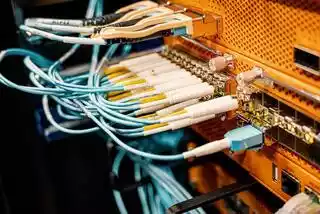Types of Computer Networks: Their Features, Advantages, Disadvantages, and Examples
Computer networks enable the seamless exchange of information. These networks connect devices, allowing them to communicate and share resources effectively.
In this article we will look into several types of computer networks, shedding light on their meanings, features, advantages, disadvantages, and where they are applicable.
Table of Contents
What is a Computer Network?
A computer network refers to a collection of interconnected devices, such as computers, servers, routers, and switches, that communicate and share resources with each other.
These devices are linked together through various communication channels, such as wired or wireless connections, to facilitate the transfer of data and information.
Types of Computer Networks
Computer networks come in various types, each serving different purposes and covering different areas. Let’s explore the different types of computer networks:
There are several types of computer networks:
- Local Area Network (LAN)
- Wide Area Network (WAN)
- Metropolitan Area Network (MAN)
- Personal Area Network (PAN)
- Campus Area Network (CAN)
- Storage Area Network (SAN)
- Virtual Private Network (VPN)
- Intranet
- Extranet
Now, let’s dive into each type of network in detail.
1. Local Area Network (LAN)
A Local Area Network (LAN) is a network confined to a specific geographical area, such as a home, office, or school. It allows devices in close proximity to communicate and share resources.
Features:
- Limited geographical area coverage.
- High-speed data transfer within the network.
- Typically, uses Ethernet cables or Wi-Fi connections.
Advantages:
- Fast and efficient communication between devices.
- Easy sharing of resources like printers and files.
- Enhanced security within the local network.
Disadvantages:
- Limited coverage area, requiring additional infrastructure for expansion.
- May suffer from congestion and slower speeds with increased devices.
- Vulnerable to security breaches if not properly secured.
Applicable Examples:
- Home networks connecting computers, printers, and smart devices.
- Office networks facilitating internal communication and file sharing.
2. Wide Area Network (WAN)
A Wide Area Network (WAN) spans a larger geographical area, connecting multiple LANs or other networks. It enables long-distance communication and data transfer between geographically dispersed locations.
WANs often utilize telecommunication links, such as leased lines or satellite connections.
Features:
- Wide geographical coverage, often spanning cities, countries, or even continents.
- Utilizes telecommunication links for long-distance data transmission.
Advantages:
- Enables communication and data sharing between geographically distant locations.
- Supports large-scale connectivity for organizations with multiple branches.
- Facilitates access to internet resources and services.
Disadvantages:
- Slower data transfer rates compared to LANs due to the vast geographical coverage.
- Requires additional setup and configuration for secure and efficient data transmission.
- It relies on external telecommunication infrastructure, making it susceptible to disruptions.
Applicable Examples:
- Internet connections that provide access to global online services.
- Wide-scale enterprise networks connecting offices across different cities or countries.
Read on: Difference Between LAN and WAN With Examples
3. Metropolitan Area Network (MAN)
A Metropolitan Area Network (MAN) covers a larger area than a LAN, but is smaller than a WAN. It connects various organizations and institutions within a city or metropolitan area.
MANs typically utilize high-speed connections like fiber-optic cables.
Features:
- Covers a specific city or metropolitan area.
- Uses high-speed connections like fiber-optic cables for data transmission.
Advantages:
- Facilitates efficient communication between organizations within a city.
- Enables resource sharing and collaboration on a larger scale.
- Supports high-speed data transfer within the metropolitan area.
Disadvantages:
- Costly to implement and maintain compared to LANs due to infrastructure requirements.
- Limited coverage area may require additional networks for broader connectivity.
- Vulnerable to disruptions and performance issues if not properly managed.
Applicable Examples:
- Cable TV networks that provide data and television services within a city.
- Educational institutions or government organizations within a specific metropolitan area.
4. Personal Area Network (PAN)
A Personal Area Network (PAN) is a network designed for individual use, connecting personal devices like smartphones, tablets, and wearable technology.
PANs often utilize technologies like Bluetooth or Near Field Communication (NFC) to establish short-range connections.
Features:
- Limited coverage area, typically within a person’s immediate vicinity.
- Utilizes wireless technologies like Bluetooth or NFC.
Advantages:
- Enables seamless communication and data transfer between personal devices.
- Supports convenient synchronization and sharing of data.
- Provides personalized and private network connectivity.
Disadvantages:
- Limited range restricts communication to devices in close proximity.
- Relatively slower data transfer speeds compared to other networks.
- Interference from nearby devices can impact network performance.
Applicable Examples:
- Connecting a smartphone, smartwatch, and wireless earphones in close range.
- Using Bluetooth to transfer files between a laptop and a smartphone.
5. Campus Area Network (CAN)
A Campus Area Network (CAN) is a network that interconnects multiple LANs within a university campus, corporate campus, or any large-scale organization.
CANs facilitate seamless communication and resource sharing between different departments and buildings within the campus.
Features:
- Covers a specific campus area or large-scale organization.
- Interconnects multiple LANs for efficient communication and resource sharing.
Advantages:
- Enables collaboration and information sharing within a campus or organization.
- Facilitates centralized management and control of network resources.
- Supports high-speed data transfer between different departments or buildings.
Disadvantages:
- Requires extensive infrastructure and network equipment for implementation.
- Maintenance and expansion can be complex and costly.
- Network performance may be affected by distance between buildings or congestion.
Applicable Examples:
- University campus networks connecting academic buildings, libraries, and dormitories.
- Corporate campus networks linking office buildings, data centers, and research facilities.
6. Storage Area Network (SAN)
A Storage Area Network (SAN) is a specialized network that provides high-speed access to consolidated, block-level data storage.
SANs are designed to connect storage devices like disk arrays, tape libraries, and servers, enabling efficient data storage and retrieval.
Features:
- Specialized network dedicated to storage access and management.
- Connects storage devices like disk arrays and tape libraries.
Advantages:
- Enables centralized and efficient storage management.
- Supports high-speed data transfer between storage devices and servers.
- Provides scalable and flexible storage solutions for organizations.
Disadvantages:
- Requires expertise and specialized equipment for setup and configuration.
- Costly to implement and maintain compared to traditional storage solutions.
- Complexity may lead to potential data management and security challenges.
Applicable Examples:
- Enterprise-level storage systems in data centers.
- Media production environments requiring high-speed storage access.
7. Virtual Private Network (VPN)
A Virtual Private Network (VPN) is a secure network that allows users to access a private network over a public network, such as the internet.
VPNs use encryption and tunneling protocols to ensure secure communication and protect sensitive data.
Features:
- Enables secure communication over a public network like the internet.
- Uses encryption and tunneling protocols to protect data.
Advantages:
- Provides secure remote access to private networks for remote workers.
- Ensures confidentiality and privacy of data transmitted over public networks.
- Allows organizations to extend their private network securely to different locations.
Disadvantages:
- Slower connection speeds compared to direct local network access.
- Reliance on reliable internet connectivity for seamless operation.
- Requires additional setup and configuration for secure VPN connections.
Applicable Examples:
- Remote workers accessing their company’s internal network securely.
- Organizations establishing secure connections with branch offices.
8. Intranet
An Intranet is a private network that uses internet protocols and technologies within an organization. It serves as a communication and collaboration platform, providing access to internal resources, documents, and services.
Features:
- Restricted access limited to employees or members of the organization.
- Provides internal communication, collaboration, and information sharing.
Advantages:
- Facilitates efficient internal communication and collaboration.
- Centralizes access to company resources, documents, and applications.
- Supports streamlined information sharing and knowledge management.
Disadvantages:
- Requires ongoing maintenance and regular updates to ensure security.
- Initial setup and customization can be time-consuming and costly.
- Reliance on network infrastructure and internet connectivity for operation.
Applicable Examples:
- Corporate intranets used by employees for accessing company resources.
- Educational institution intranets for sharing course materials and administrative information.
Read on: What Is the Difference Between Ethernet and Intranet?
9. Extranet
An Extranet is a network that allows controlled external access to a specific part of an organization’s internal network. It enables collaboration and information sharing with external partners, suppliers, or clients while maintaining security and privacy.
Features:
- Limited and controlled access to external entities.
- Enables collaboration and information sharing with external partners.
Advantages:
- Facilitates secure communication and collaboration with external entities.
- Enhances coordination and integration with suppliers, partners, or clients.
- Enables controlled sharing of confidential information with authorized parties.
Disadvantages:
- Requires robust security measures to protect sensitive data from unauthorized access.
- Management and monitoring of external access can be complex.
- Reliance on secure authentication and access control mechanisms.
Applicable Examples:
- Supplier portals, allowing vendors to access inventory or ordering systems.
- Customer extranets providing access to specific services or information.
10. Content Delivery Network (CDN)
A Content Delivery Network (CDN) is a distributed network of servers strategically placed across different geographical locations.
Its purpose is to cache and deliver content, such as web pages, images, videos, and other media, to users based on their geographic proximity to the servers.
Features:
- CDNs consist of servers located in various regions or data centers.
- Content is cached and stored on CDN servers to reduce latency.
- Multiple server locations ensure content availability and resilience.
- CDNs distribute content requests across servers for efficient handling.
- Cached content is delivered from nearby servers, reducing network congestion and improving speed.
Advantages:
- CDNs deliver content from servers closer to users, reducing latency and improving page load times.
- CDNs have servers distributed worldwide, enabling content delivery to users across different regions.
- It can handle high traffic loads by distributing content requests across multiple servers.
- Faster content delivery leads to better user experience and engagement.
Disadvantages:
- Implementing and maintaining a CDN can involve additional expenses, especially for high-traffic websites.
- Configuring and managing a CDN requires technical expertise and ongoing monitoring.
- If a CDN server goes down or experiences issues, it can affect content delivery.
Applicable Examples:
- CDNs are commonly used by online retailers to deliver product images and web pages quickly to customers.
- It enables smooth and uninterrupted streaming of video and audio content.
- CDNs help distribute news articles, images, and videos to a wide audience efficiently.
Types of Computer Networks: Their Features, Advantages, Disadvantages, and Examples in Tabular Form
| Network Type | Features | Advantages | Disadvantages | Examples |
|---|---|---|---|---|
| LAN | Limited geographical area | Fast communication, resource sharing | Limited coverage, potential congestion | Home or office networks |
| WAN | Wide geographical area | Long-distance connectivity, large-scale usage | Higher cost, slower speeds over long distances | Internet, global enterprise networks |
| MAN | Metropolitan area | Efficient communication within a city | Limited coverage beyond the city | City-wide government or educational networks |
| PAN | Personal device proximity | Seamless synchronization, personal connectivity | Limited range, slower speeds compared to others | Bluetooth-connected devices |
| CAN | Campus or large-scale organization | Collaboration, resource sharing | Complex implementation, maintenance | University campus, corporate campus networks |
| SAN | Storage device access | Centralized storage, high-speed data transfer | Costly implementation, potential complexity | Data centers, media production environments |
| VPN | Secure remote access | Secure communication, remote network extension | Slower speeds compared to local connections | Remote workers accessing company networks |
| Intranet | Internal network within an organization | Internal communication, resource access | Initial setup and customization, reliance on infrastructure | Corporate intranets, educational institution networks |
| Extranet | Controlled external access | Collaboration with external entities | Security risks, management complexities | Supplier portals, customer extranets |
| CDN | Content caching and delivery | Improved website performance, global reach | Cost, potential single point of failure | Cloud-based CDN providers, e-commerce websites |
Final Thoughts
In conclusion, understanding the various types of computer networks is essential for building efficient communication systems and optimizing resource sharing.
Each network type, such as LANs, WANs, MANs, PANs, CANs, SANs, VPNs, Intranets, Extranets, and CDNs, has its own set of characteristics, advantages, disadvantages, and practical applications.
While each network type offers unique benefits, there are also considerations to keep in mind. These include potential limitations such as coverage constraints, maintenance requirements, costs, and security implications.
Organizations need to assess their specific needs and goals when choosing and implementing the appropriate network type.




